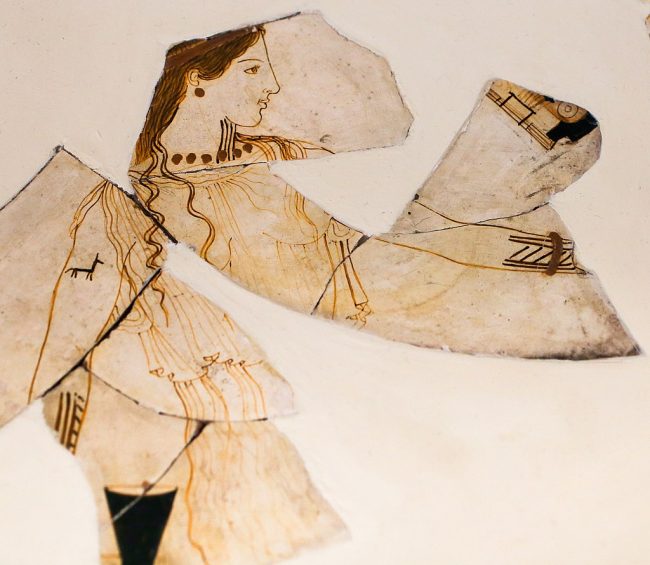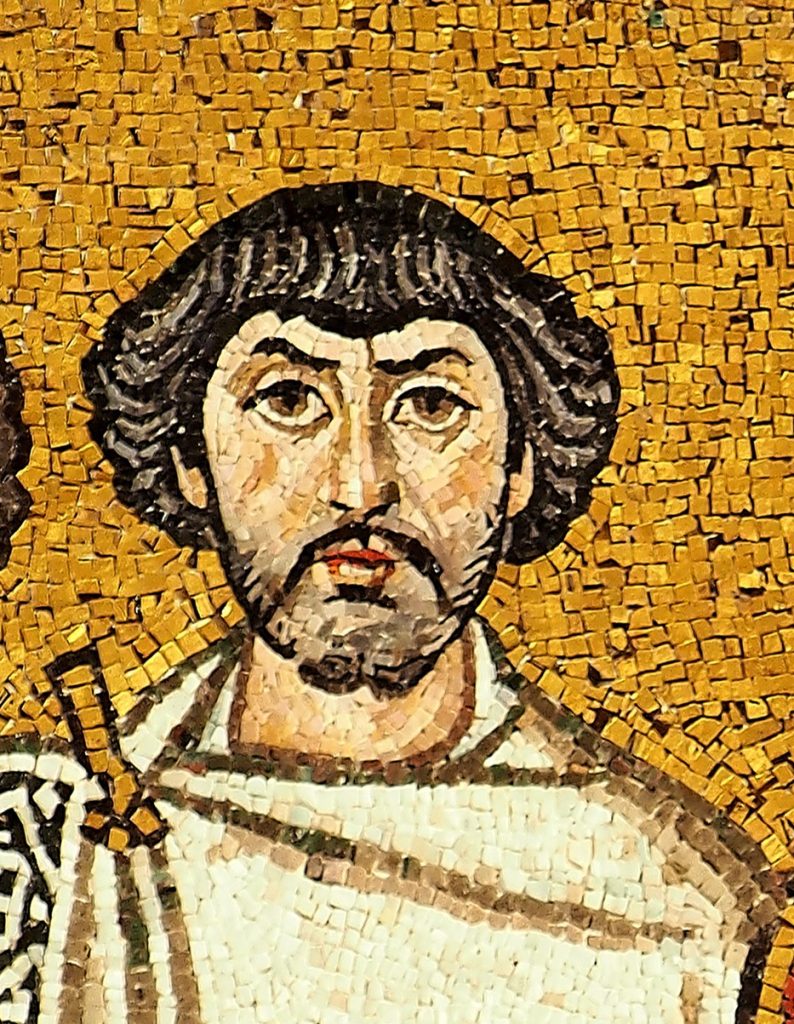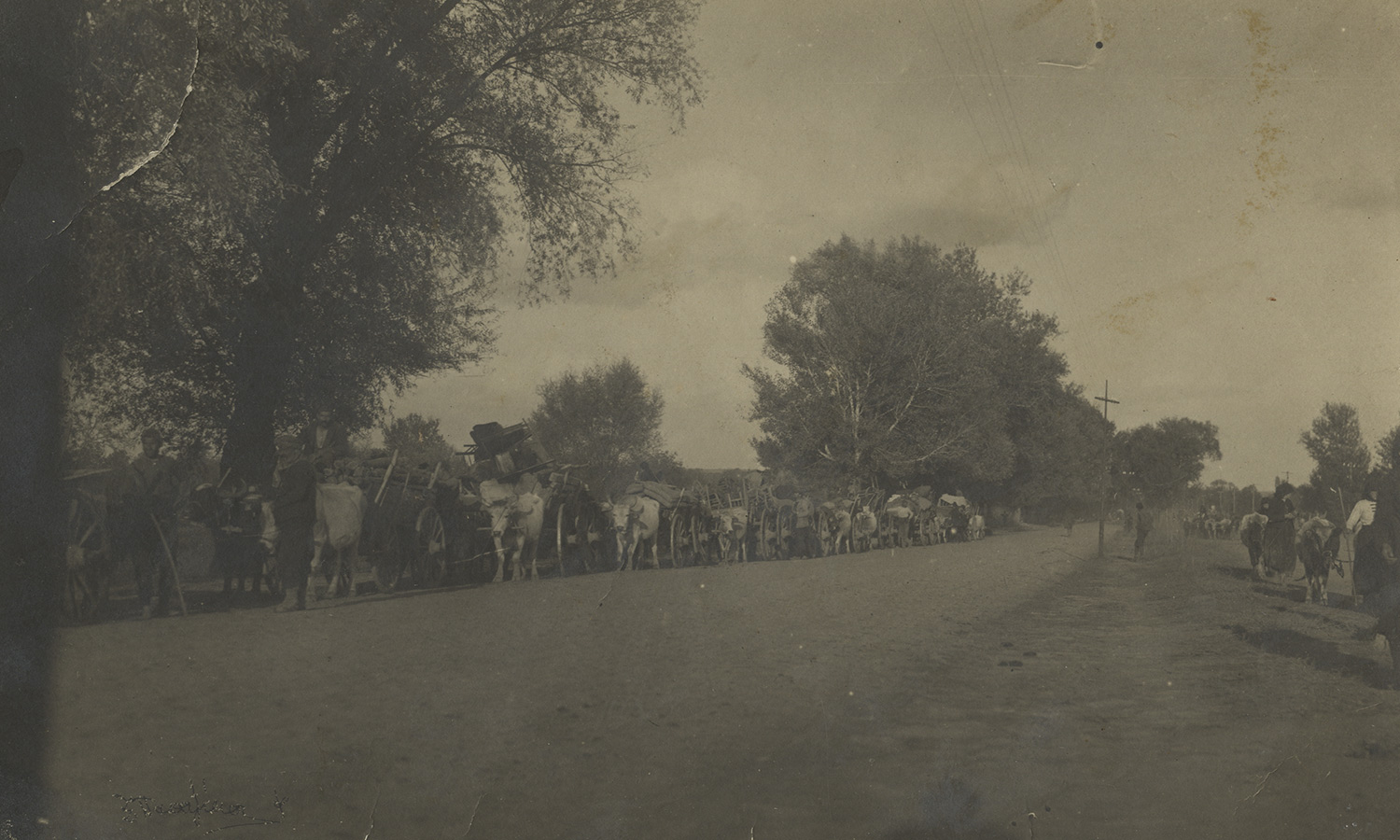Historical Timeline

Prehistoric
The Palaeolithic Era, during which human presence in
Thrace can be dated, based on archaeological finds.
The Neolithic Era in Thrace, based on archaeological
finds.
The Bronze Age in Thrace, based on archaeological finds.
The Iron Age.
Appearance of Thracian tribes, which move
from the Dniester and Danube rivers to the Aegean Sea
and from the Black Sea to the River Pineios.
Antiquity
The Ionians settled in the coastal section of Thrace.
The Persians move into the Thracian hinterland.

Creation of the first Thracian kingdom, that of the Odrysians.
Macedonian Period
Thrace is incorporated into the kingdom of Macedonia.

Roman Period
The Romans built the Via Egnatia. Thrace acquires a network for the transport of people, goods, and ideas.
Thrace became a Roman province.

Byzantine Period
Constantine the Great inaugurates the new capital of the Empire, New Rome, which came to be known with his name as Constantinople.
Flavius Belisarius, or simply Belisarius, one of the greatest
military figures of the early Byzantine period, was born in
Ormenio in northen Evros. (Germania, Chernomen).


Cities and castle are built in Thrace under Justinian I.
Descent and settlement of Slavic tribes in the northern
section of Thrace, a development that significantly
changes its demographic composition.
Bulgarian raids on Thracian cities.
The end of antiquity, which takes place in the so-called
Dark Ages, signifies a shift in the agricultural economy of
Thrace with the foundation of the themata
(administrative units) of Thrace (late 7th century) and Boleron (9th century).
Urban reorganisation of Thrace.

Emperor Basil II prevents the second wave of Bulgarian
expansion in northern Greece (hence his epithet
Voulgaroktonos, or “Bulgar Slayer”), using Mosynopolis
(Maximianopolis) in Thrace as his base.
Kosmosoteira
The sebastokrator Isaac Komnenos founds the Monastery
of Panagia Kosmosoteira in Vira (today’s Ferres).

John III Doukas Vatatzes, the second emperor of Nicaea,
is born in Didymoteicho (1222-1254).
Fourth crusade. After the fall of Constantinople to the
Franks, Thrace is renamed Romanía.
Dynastic wars between the Palaiologans Andronikos II
and Andronikos III.
Andronikos III attempts the settlement and military reorganisation of Thrace and Macedonia, building
fortresses and castles.
Emperor John V Palaiologos is born in Didymoteicho. He
was to rule officially from 1355 until his death in 1391.

Restored −and digitally enhanced− mosaic of emperor John V Palaiologos (r. 1341–1391) in the Eastern Arch of Hagia Sophia, probably the last one made in the Empire’s history.
John VI Kantakouzenos is crowned emperor at
Didymoteicho, as co-king and co-emperor with Ioannis V
Palaiologos.

Code Mutinensis gr. 122 (folio 294v) Library of Este in Montena.
Dynastic Wars
Dynastic wars between John V Palaiologos and John VI
Kantakouzenos. During these wars, troops from the
Turkish emirates of Asia Minor are used for the first time
by the rival Byzantine emperors. They disembark in
Thrace and cause, for a time, extensive destruction.
John VI Kantakouzenos is crowned emperor in
Adrianople.
The metropolitan bishop of Traianopolis transfers the
seat of his diocese to Mosynopolis, due to barbarian
raids.
John VI Kantakouzenos is crowned emperor for the third
time in Constantinople and rules until 1354.
The Ottomans capture the fortress of Tzympi in Gallipoli
and form their first permanent base in Thrace.

The Ottomans occupy Didymoteicho.
Independent Turkish beys occupy Philippopolis.
The Ottomans capture Gümülcine (today’s Komotini).
Amadeus VI, Count of Savoy, head of the Frankish knights,
captures Gallipoli and gives it to the Byzantines.
Independent Turkish beys capture and pillage
Adrianople.
The Ottomans, led by Lala Şahin and Evrenos Bey,
capture Vira, today’s Ferres (Ferecik).
The battle of Chernomen (Ormenio) on the River Evros.
The Byzantine Empire and medieval states of Serbia and
Bulgaria are defeated by the Ottomans and recognise its
suzerainty.
The Turkish beys offer Adrianople to the Turkish sultan,
who makes the city the capital of his state.
The Ottomans capture almost all the fortified towns and
settlements of today’s Greek Thrace.
Murad I recaptures Gallipoli.
The Ottomans capture Xanthi and rename it Eskice.
Sultan Mehmed I unveils a grand mosque in
Didymoteicho.
The Ottoman Sultan Mehmed II besieges and captures
Constantinople and makes it the capital of the Ottoman
Empire.
MODERN HISTORY
A berat of Sultan Bayezid II indicates that the following
metropolitan dioceses are to be found in Thrace:
Herakleia, Raidesto, Silivria, Ainos, Adrianople, Medeia,
Sozopolis, Anchialos, Mesimvria, Philippopolis and Vizyi.
The Selimiye Mosque built by Mimar Sinan is completed
in Adrianople.
The “Esnaf” (guild) of the abatzides is founded in
Philippopolis, the best-known professional guild for the
processing and production of coarse woollen fabrics in
Thrace.
The Greek school of Adrianople is built, opposite the
metropolitan cathedral.
Meletios Mitros, in his work “Geography Old and New”,
describes the Thrace of his day and includes it as part of
Greece.
The Central Greek School is founded in Philippopolis.
Establishment and operation of Greek community
schools in the towns of Tyroloi (1784), Madyto (1784),
Myriofyto (1788), Raidesto (1790 ), Ganochora (1790),
Epivates (1796), Silivria (1799), Skopos (1810), Sozopolis
(1817), and Mesimvria (1817).

The “Dimitrieis”, Daniel Philippides and Grigorios
Konstantas, publish their work “Νεωτερική Γεωγραφία”
[Modern Geography] in Vienna, in which they describe
Thrace, including it in the “provinces” of “European
Greece”.

The Friendly Society recruits members from Thracian
cities such as Philippopolis, Mesimvria, Maroneia, Ainos,
Varna, Gümülcine, Adrianople, Sozopolis, Anchialos,
Madyto, Lüleburgaz, and Agathoupolis.
After the declaration of the Greek War of Independence
in Thrace, the Ottomans quash the revolutionary groups
with harsh reprisals.
The Metropolitan Bishop Paisios declares the uprising of
the local Christians in Sozopolis. The Ottomans crush the uprising and pillage Sozopolis.
The former Ecumenical Patriarch, Cyril VI, is hung in
Adrianople. The previous day, Christian notables of the
city were also executed by the Ottoman authorities.
The uprising Christians of the region of Lavara are
defeated by the Ottomans.
The revolutionary movement of the Christians of Gallipoli
extends to the neighbouring villages of the Thracian
hinterland (Kessani, Malgara, etc.) but is soon crushed by
the Ottomans.

The Ottoman fleet, during its return from revolutionary
Greece, lands military detachments on Samothrace, which
cause extensive destruction. Over 700 of the island’s
Christians are slaughtered and many are driven to the
slave bazaars.
“Après le Massacre de Samothrace” («Μετά τη σφαγή της Σαμοθράκης”) (1827)
Russo-Turkish war. The Russians march as far as Thrace.
C. Sayger and A. Desarnod, in the service of the Russian
army, produce a splendid study of eastern and northern Thrace in “Relation d’un Voyage fait en Turquie”.
The five neomartyrs of Samothrace protest in Makri:
Manuil, Theodoros, Georgios, Michail and Georgios.
Reform decrees (Tanzimat): Hatt-i Sherif (1839) and Hatt-
i humayun (1856).
The Greek Philological Association of Constantinople is
founded.
Associations and societies are established in almost all
the towns and villages of Thrace, which play an
important role in the national, religious and spiritual self-
consciousness of Thracian Hellenism — in Saranta
Ekklisies (1865), Vizyi (1865), Philippopolis (1869), Ainos
(1871), Adrianople (1872), Arkadioupolis (1872), Madyto
(1875), Babaeski (1878), Mesimvria (1881), Ferres (1885),
Didymoteicho (1885), Komotini (1895), Kavakli (1896),
Raidestos (1897), Xanthi (1900) and Soufli (before 1920).
As part of the administrative reorganisation of the
Ottoman Empire, which takes place with the Tanzimat
(1839-1856), “greater Thrace” is, until 1878, a unified administrative region with the name Vilayet of Edirne
(Adrianople).
The Association for the Propagation of Greek Letters is
founded in Athens. Together with the Greek Philological
Association of Constantinople, it undertakes the great
task of establishing and operating schools throughout the
whole of Thrace.
An agreement is signed between the Ottoman Empire
and Baron Hirsch for the construction of a railway
network, which, with one line and four branches, will
connect Constantinople with Central Europe. One branch
will connect Adrianople with Dedeağaç (Alexandroupolis
after 1920).
The Bulgarian Exarchate is recognised with a sultanic
firman.
The connection between Dedeağaç and Adrianople is
completed and parallel work on the construction of the
port at Dedeağaç progresses.

The consular office of Greece is established in Dedeağaç.
The consular office of Greece in Dedeağaç is upgraded to
a vice consulate.
Russo-Turkish war, which ends with the defeat of the
Ottoman Empire.
The Russians occupy Dedeağaç. Russian army engineers
draw up the first street plan of the then small town of
Dedeağaç.
The Treaty of San Stefano is signed between Russia and
the Ottoman Empire. According to the treaty, the
independent Principality of Bulgaria is established,
incorporating the northern and southern sections of
“greater Thrace”.
At the Congress of Berlin, the Great Powers of the day
revise the Treaty of San Stefano. Bulgaria’s independent
principality is scaled back. The semi-autonomous
administration of Eastern Rumelia is created, which
includes northern Thrace.

The French Compagnie d’Exploitation des chemins de Fer
Orientaux is founded. Its concession is later granted to
German and Viennese bankers.

The lighthouse of Dedeağaç is inaugurated, one of the
tallest lighthouses in the eastern Mediterranean and a
symbol of the city.
The seat of the sanjak is transferred from Didymoteicho
to Dedeağaç.
Dedeağaç and its surrounding villages are detached from
the metropolitan diocese of Maroneia and become part
of the metropolitan diocese of Ainos. In the same year,
the seat of the metropolitan diocese is transferred from
Ainos to Dedeağaç.
Bulgarian attacks on the Greek school of Philippopolis.
Bulgaria unilaterally annexes the semi-independent
administration of Eastern Rumelia.

The Franco-Belgian company Jonction Salonique –
Constantinople (J.S.C) starts work on the Thessaloniki-
Evros railway line.
Map shows still existing main line in red and abandoned or razed branch lines in brown. Other railway lines shown in black. Map background shows borders of 2018
Work is completed on the new J.S.C. railway line.
Bulgarian nationalists provoke serious incidents and
destruction in almost all the Greek communities of
Eastern Rumelia (Philippopolis, Stenomacho, Haskioi,
Kavakli, Sozopolis, Mesimvria, and elsewhere), peaking
with the burning of Agchialos.
Young Turk revolution. With the establishment of the
Turkish nationalist party in Thrace, the persecution of
Christians, whom the movement collectively consider
enemies that undermine the unity of the Turkish nation-
state, became widespread.

During the First Balkan War, Bulgaria occupies western
Thrace.

End of the First Balkan War with the signing of the Treaty
of London.
Second Balkan War. During the war, the Greek army,
backed by the navy which sailed along the length of the
Thracian coast, scores remarkable victories, entering Kavala, Xanthi, Komotini and Dedeağaç.

The Treaty of Bucharest is signed, ending the Second
Balkan War. Western Thrace is ceded to Bulgaria, while
Eastern Thrace remains under Ottoman rule.
Photo Bild und Film Umt – Grosser Bilderatlas des Weltkrieges
The provisional Administration of Gümülcine is created.
A convention is signed in Constantinople between
Bulgaria and the Ottoman Empire, providing for the
“voluntary” exchange of the Muslims and Bulgarians who
are settled at a distance of 15 kilometres west and east
of the River Evros.

The Bulgarian army occupies Thrace and Dedeağaç
(Alexandroupoli).

First World War. The Ottoman Empire sides with the
Central Powers of Germany, Austria-Hungary and
Bulgaria.
Image: Imperial War Museums
An agreement is signed in Constantinople between Bulgaria and the Ottoman Empire, according to which the
latter concedes to Bulgaria the northern section of
today’s Regional Unit of Evros, with a total area of
approximately 1,500 square metres. In this way, almost
the whole of western Thrace comes under Bulgarian
control.
Attack by the Allied Powers of the Entente on the
Dardanelles. The Allied fleet bombs the coastal zone of
Thrace and Dedeağaç, which are under Bulgarian control.
Capture of eastern Macedonia by German and Bulgarian
troops.
The National Defence Movement is founded and the
Provisional Government of Thessaloniki is formed, led by
Eleftherios Venizelos.
Greece enters the war on the side of the Allies.

End of the First World War, with the victory of the
Entente powers. The Turks sign the Armistice of Mudros.
Bulgaria, defeated as a member of the Central Powers,
signs the Armistice of Salonica, which obliges it to withdraw its troops from western Thrace.
Evening Standard from the 11th November 1918, Cunninghame Graham Papers (ANCG II)
Creation of the Inter-Allied Zone in western Thrace under
French administration.
Entente troops, including Greek troops, occupy western
Thrace.
Greek troops occupy the Xanthi “triangle”, with
instructions to maintain security and order within the
framework of the Entente decisions on the autonomy of
“Inter-Allied Thrace”.
The Allies declare Thrace a provisionally autonomous
territory (Thrace Interalliée), with its own administration
and French as the official language.
The Treaty of Neuilly is signed between the Allies of the
Entente and Bulgaria. The latter renounces all its claims
to Thrace.
At San Remo, the Allies decide to replace the allied
troops that were based in Thrace with Greek troops, which receive the order to maintain the “Inter-Allied
status”.
Greek troops enter Thrace with instructions to maintain
public order and security, until the area’s eventual fate is
decided.
Greek troops triumphantly enter Alexandroupolis.
Greek troops triumphantly enter the historic city of
Didymoteicho.
Cafer Tayyar declares the autonomy of eastern Thrace.
His movement ends ingloriously with his arrest by Greek
troops.
Greek troops triumphantly enter Adrianople. The General
Administration of Thrace is formed, headed by Consul
Antonios Sachtouris.

Signing of the Treaty of Sevres. Among other items, the
Treaty contains provisions on Thrace and confirms the
annexation of Western Thrace to Greece, on the basis of
the Treaty of Neuilly.
Collapse of the Asia Minor front. Asia Minor Catastrophe
and defeat of Greece.

Greece signs the Armistice of Mudanya and is obliged,
within 15 days, to evacuate eastern Thrace. Two hundred
thousand Thracians abandon their ancestral homes.
The Greek delegation hands the administration of
Adrianople to the Inter-Allied Commission.

The Treaty of Lausanne officially concludes the three-way
partition of Thrace. In a special protocol, the Allies ratify
the Treaty on Thrace of 10 August 1920, according to
which western Thrace is awarded to Greece.
Keystone-France/Gamma-Keystone via Getty Images
Within the framework of the Greek-Bulgarian agreement
for the voluntary and mutual exchange of minority
populations, approximately 50,000 Greeks depart
northern Thrace.
